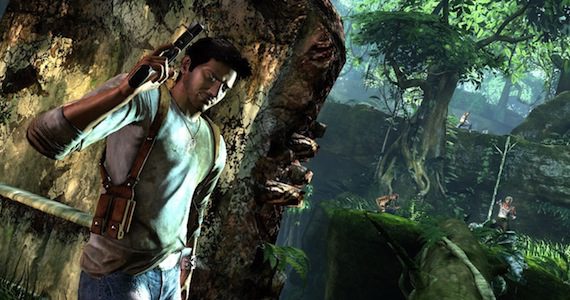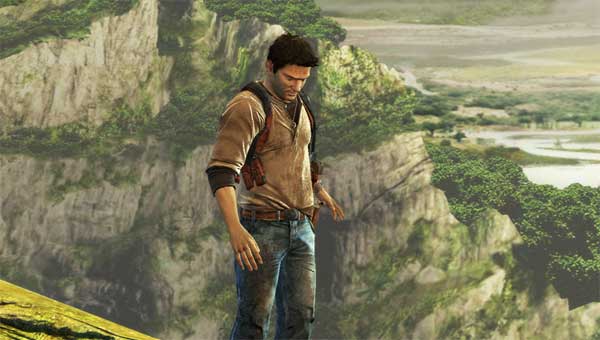There is a lot riding on Uncharted: Golden Abyss. Not only is it from Bend Studios, the first outside of Naughty Dog to tackle the series, but it is tasked with proving that the Vita can deliver a console size experience. After three entries, there are certain cornerstones of Uncharted; namely, the wit and humor, ancient ruins, cinema quality action sequences, and mass murder. For the most part, Uncharted feels like all the others, and in some ways surpasses Uncharted 3, the weakest entry in my opinion. Shoehorning in touchscreen controls kept Golden Abyss from truly hitting console quality, although it sets an incredibly high bar for action games going forward.
Golden Abyss is a prequel to the existing games; a smart move, giving Bend the chance to dial back much of the lore from the Playstation 3 entries and form their own tale. A relatively young and naive Nathan Drake is traversing through Central America, hunting treasure with his Goodfellas-inspired buddy Dante. They become entangled with beautiful archaeologist Chase, who is trying to build upon her grandfather’s legacy and track down a lost city. Things are complicated by the ridiculously stereotyped General Guerro and his desire to keep the wealth of the city for himself. It is a story that follows all the main lines of the other Uncharted games. There are romantic undertones tempered with sarcasm and danger, a sadistic leader with an unlimited amount of men willing to be shot, a friend that may or may not be playing for the other team, and ancient cities scattered across the country side. Anyone expecting something new will be disappointed.
Thankfully, the script that Bend is following is an effective one. Nolan North plays Nathan Drake with the same enthusiasm as always, and while the dialogue is certainly laughably weak at times, he sells it as best as he can. The cadre of side characters you encounter on your journey are passable, and there are countless digs at the series itself, adding a level of self awareness that forces you to forgive any missteps along the way.
While the characters have always made Uncharted memorable, it is the game play that made it a blockbuster. The most surprising part of Golden Abyss is how well the controls of the PS3 translate to the handheld. Shooting works exactly like the console version, using the left trigger to aim more precisely, as well as being able to run and gun or blind fire when needed. Cover is also a direct translation, making combat a simple leap for anyone that has picked up Uncharted before this. Battles even feel like they match the scale of the PS3 games. The arenas are massive, with a huge amount of verticality and variation from point to point. Enemies come in a wide variety of forms, and the weapon cache is huge and diverse. During most action sequences I was surprised just how sucked in I was and how hard I was gripping the Vita. Golden Abyss features some of the best combat sequences of any third-person shooter this generation, no small feat for a developer approaching the series for the first time.
Drake is without question one of the most prodigious mass murders in video games, but the man’s tendency to scale walls instead of grabbing a ladder is also vital to the character. While the depth and size of the combat was a delight, the platforming sections of Golden Abyss actually surpass the predecessors. Like any other game that requires you to climb buildings or cliffs, accidentally hopping Nathan off a cliff or missing a jump lead to a great deal of frustration. Bend incorporated the touchscreen to help alleviate most of that. Touching the ledge you want to reach causes Nate to blaze the trail automatically, eliminating the need to constantly press over and X. It also prevents many a stupid death. There are limitations, and more complicated areas take practice and precision, but the mundane blunders are mostly taken care of, leaving you with more time to explore and less time looking at loading screens. Using the screen to navigate has to be deliberate, and simply brushing the screen won’t cause Drake to respond, which is far better than accidently launching you somewhere you don’t want to be. It was a tough balance for them to work with, but out of all the new innovations, climbing is the most natural and enjoyable.
Sadly, the fun with the touchscreen ends there. Golden Abyss is a surprisingly long game, over 10 hours, and you will spend a great deal of it playing with the screen. There are numerous actions you have to use the screen for, and at first it is fun and novel, but around hour 5, I wanted to rip the screen off. A part of treasure hunting now involves making charcoal rubbings, meaning you run your finger over a piece of the screen until the image shows. You are also forced to “clean” objects off in order to find clues, using the back screen to rotate it while running your finger over it to remove dirt. These things happen dozens of times, and more often than not little parts fail to read the action, forcing you to run your finger over every inch trying to find the little you missed. There are touch puzzles too, as well as a puzzle that required me to hold the Vita camera up to a light source, which took far too long to register and would be impossible without a strong lamp next to you. The gimmicky feel to these actions constantly took me out of the game. Just when I forgot I was even playing on a handheld, I was forced to rub off some dirt, all the while feeling like Sony was over my shoulder yelling, “Look how cool the Vita is!”
If it was just the two aforementioned uses of the screen, I could forgive them, but it isn’t. Touch controls also dominate melee combat. Uncharted became more and more melee focused through each iteration, and Golden Abyss follows that trend. You have the option of touching the enemy or using the square button, which is fine. However, at the climax of each attack, you have to follow the swipes on the screen, usually two or three, in order to win. It is a horrifically frustrating action. The most egregious use is during two major battles which are composed entirely of swiping, 30 or so swipes in all, and if you miss three, you die and start from the beginning. Given that the screen isn’t always 100% at reading swipes, these climactic battles are the worst feature in the game, and the most unsatisfying. You also have two sections of boating, around 10 minutes each, which simply require you to swipe down to paddle while you listen to exposition. These last far too long and hamper the excitement of the rest of the game.
Outside of the missteps, Golden Abyss still managed to amaze me far more often than it frustrated me. While it doesn’t feature the massive changes in scenery typically found in Uncharted, the jungle settings are gorgeous, many times matching up to the quality of the first game. The size and scope of each area put many console games to shame, and the combat is still addicting as ever. Even the cinematography can be breathtaking from time to time. If the goal was to prove that the Vita can compete with console games in terms of quality and size, then Golden Abyss knocks it out of the park. The gimmicks dampen the game at times, and the exclusion of Elena and Chloe and the small dose of Sully hurt the story, but as a whole, Golden Abyss justifies the high expectations for the Vita and sets the standard for quality going forward.
Review
| Pros | Cons |
|---|---|
| Amazing graphics. Addictive combat. Feels like a full console game. Polished and original | Too much time spent focused on gimmicks with the touch screen. |
| Rating |





